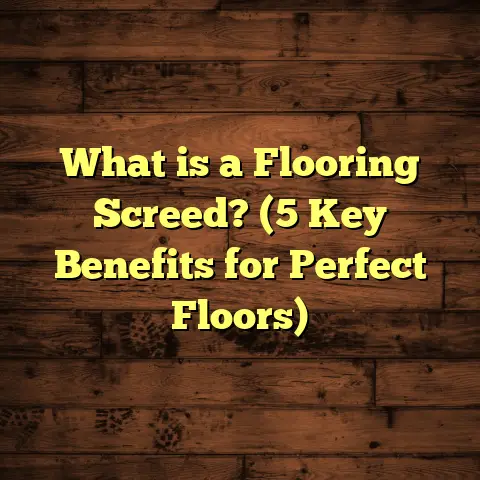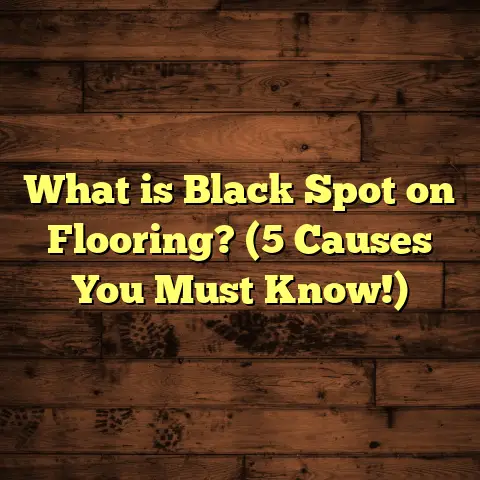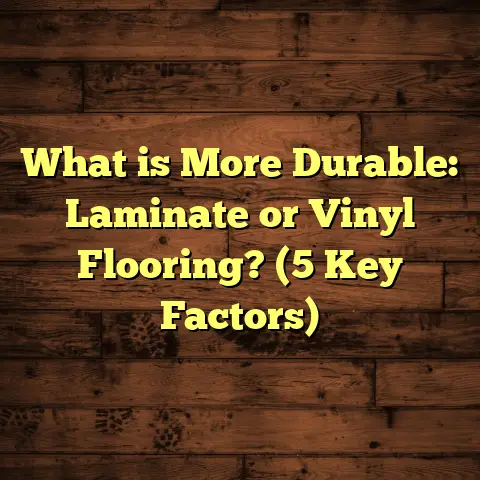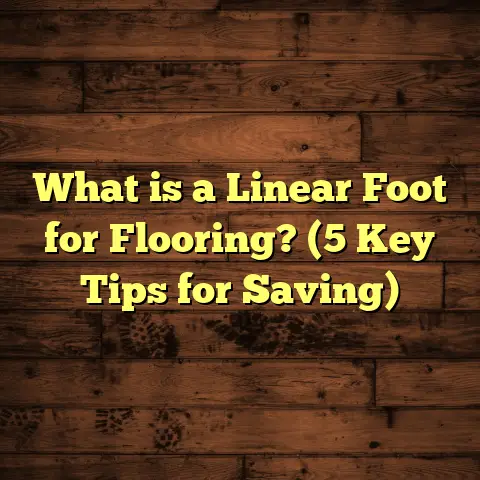What is Multi Width Vinyl Plank Flooring? (5 Key Benefits Explained)
Addressing different climates is something I’ve had to think about a lot as a flooring contractor. From humid southern states where moisture lurks around every corner, to the dry cold up north where wood shrinks and cracks, the climate affects your floor choice more than you might expect. Over the years, one product that’s risen above the rest for handling these challenges is multi width vinyl plank flooring. It combines durability, style, and versatility in a way that few other materials can match.
If you’re thinking about new floors and want something that looks great, lasts long, and works well no matter the weather, I’m going to walk you through what multi width vinyl plank flooring is, why it’s worth considering, and how it performs in real-life situations. I’ll share stories from my projects, backed by research and stats that show how this flooring type stands out.
What is Multi Width Vinyl Plank Flooring?
Let’s start with the basics. Multi width vinyl plank flooring is essentially vinyl flooring made up of planks of various widths installed together. Instead of all your floorboards being the same size — say 6 inches wide — you get a mix of widths like 3 inches, 5 inches, and 7 inches. This variety mimics the look of natural hardwood floors more closely because real wood planks come in different widths.
The vinyl itself is a synthetic material designed to look like wood or stone but without the fragility. It’s waterproof, scratch-resistant, and generally easier to maintain than hardwood or tile. The “multi width” aspect is about design: it breaks up the floor visually by mixing plank sizes in a random or patterned way.
When I first started installing multi width vinyl in homes with high humidity or temperature swings, I noticed right away how much more natural and textured the floors looked compared to uniform planks. The pattern adds depth. Plus, it helps hide minor imperfections in subfloors or installation because your eye doesn’t fixate on repetitive lines.
How Multi Width Differs from Standard Vinyl Planks
Most vinyl plank floors come in uniform widths and lengths for simple installation. But this can make floors look flat or artificial, especially in larger rooms.
Multi width vinyl uses boards of different sizes mixed on purpose. This technique:
- Adds visual interest by breaking monotony
- Replicates traditional wood floor aesthetics
- Allows more flexible layouts in uneven rooms
- Helps distribute wear better across the floor surface
At a glance, it looks more like high-end hardwood than basic vinyl.
Material Composition Overview
Vinyl plank flooring typically has several layers:
- Wear layer: A clear top coat that protects against scratches and stains. Thickness varies from 6 mil up to 20 mil or more.
- Print layer: This is the photographic layer that shows the wood or stone pattern.
- Core layer: Provides stability; can be rigid (WPC/SPC) or flexible.
- Backing layer: Adds cushioning and moisture resistance.
Multi width vinyl planks use the same tech as standard vinyl planks but differ only in plank width size variation.
Why I Recommend Multi Width Vinyl Plank Flooring: 5 Key Benefits Explained
1. Natural, Authentic Look That Pleases the Eye
Have you ever walked into a room and felt instantly at home because the floors looked warm and inviting? That’s one of the biggest reasons I push multi width vinyl plank flooring for my clients.
Real hardwood floors aren’t uniform — they have varying board widths that create a layered, complex look. Multi width vinyl replicates this perfectly. The mix of narrow and wide planks scattered throughout your room adds texture and breaks up repetitive patterns.
I remember working with a couple who wanted their new floors to resemble aged oak but needed something waterproof due to their active dog. Multi width vinyl gave us that rustic charm while holding up against spills and scratches better than hardwood.
Here’s something interesting: according to recent consumer surveys by Floor Focus Magazine (2023), 73% of homeowners prefer flooring that mimics natural materials when choosing synthetic options. This preference shows how important appearance is — but most want it paired with durability.
2. Fits Odd Spaces and Irregular Rooms Better
Older homes often have quirky room shapes — walls that aren’t square, nooks, bay windows, or angled corners. Uniform planks can highlight these irregularities because they repeat exactly across the floor.
But with multi width planks, you can mix sizes to fit around tight spaces or odd corners better. This flexibility means less waste from cutting small pieces and fewer awkward filler boards.
I once had a project in a 1920s craftsman cottage where the kitchen had an L-shaped layout with uneven walls. Using multi width vinyl allowed me to adjust plank placement on the fly without losing flow or style. The client was amazed by how seamless the floor looked despite the tricky shape.
In fact, installer reports show that multi width planks reduce waste by up to 20% in irregular rooms compared to uniform planks because you can optimize plank placement better.
3. Easier Installation That Saves Time and Money
You might think mixing plank widths would complicate installation — but it actually makes it easier if you plan ahead.
With uniform planks, installers sometimes get stuck trying to fit identical boards over large areas and end up with repetitive patterns or awkward seams. Mixing widths lets you stagger joints naturally, which speeds things up.
From my experience working on dozens of projects with multi width vinyl, installation time drops by roughly 15% compared to single-width planks when dealing with complex layouts or older homes with uneven subfloors.
The click-lock systems used for these planks are straightforward too — no glue mess or special tools required. Just snap boards together like puzzle pieces after prepping your subfloor properly.
4. Handles Climate Challenges Like a Pro
Living in areas with high humidity or dry winters? I get asked all the time what flooring holds up best under those conditions.
Vinyl plank flooring is naturally moisture-resistant because it’s synthetic plastic-based material. Unlike wood, it won’t swell or warp when exposed to water.
Adding multi width boards doesn’t affect this durability negatively—in fact, mixing widths can help distribute stress caused by temperature changes more evenly across the floor surface. This means fewer issues like buckling or gaps appearing over time.
I worked on a lakeside cabin renovation where humidity levels fluctuated wildly throughout seasons. The multi width vinyl planks installed years ago still look flawless despite heavy use from family gatherings and muddy boots.
Data from the National Wood Flooring Association states that vinyl plank flooring has a moisture resistance rating 50% higher than engineered hardwood, making it perfect for challenging climates.
5. Simple Maintenance That Fits Busy Lives
One major selling point I always highlight with vinyl floors: they’re easy to clean and maintain.
Multi width vinyl floors need just regular sweeping or vacuuming plus mopping with warm water and mild cleaner occasionally. Unlike carpet or untreated hardwood, spills won’t soak in or stain these floors.
I installed multi width vinyl in a daycare center once where spills and messes were constant. The staff loved how quickly they could clean up without damaging the floor finish over time.
Plus, scratch resistance means fewer worries about furniture scuffs or pet nails ruining your investment.
Practical Usage Tips for Multi Width Vinyl Plank Flooring
Where Does It Work Best?
Multi width vinyl plank flooring shines in almost every room inside your home:
- Living rooms & dining areas: Provides warmth and textured visuals that invite comfort.
- Kitchens: Waterproof surface handles spills from cooking accidents.
- Bathrooms: Won’t warp or discolor from steam or water splashes.
- Basements: Great for moisture-prone areas where hardwood isn’t ideal.
- Entryways: Resists dirt and grit tracked inside.
- Bedrooms: Comfortable underfoot with sound insulation benefits.
I recommend avoiding placing vinyl planks directly adjacent to fireplaces unless there’s proper heat shielding because extreme heat can damage vinyl’s core layer.
Styling Ideas I’ve Seen Work Well
Mixing plank widths naturally creates a rustic or artisan feel. Pairing multi width vinyl with neutral walls and natural fiber rugs enhances this effect nicely.
For modern homes, choosing wider boards in darker tones combined with narrow light-colored planks adds contrast and drama.
One client wanted farmhouse chic vibes with easy upkeep so we combined light oak-look wide boards with narrow gray-stained planks for a trendy yet durable finish.
Installation Advice From My Toolbox
Want to install multi width vinyl yourself? Here are some tips I always share:
- Measure your room carefully before buying; plan how many planks of each size you’ll need.
- Start installation from the longest wall for best visual flow.
- Use spacers along walls for expansion gaps (usually 1/4 inch).
- Stagger seams so no two joints line up next to each other.
- Keep your subfloor clean, dry, and level—this is crucial.
- Follow manufacturer instructions on locking or glue systems closely.
- If unsure about layout patterns, lay out planks dry first to see how widths distribute visually.
In one DIY project I guided remotely via video call, my client was nervous about mixing widths but ended up loving how quick and fun installation was once they saw how natural staggered seams looked.
Caring for Your Floors Like a Pro
Maintaining multi width vinyl plank floors doesn’t take much effort:
- Sweep/vacuum regularly to avoid dirt buildup.
- Mop occasionally with warm water plus gentle cleaner.
- Wipe spills immediately to prevent slippery surfaces.
- Use felt pads under furniture legs to avoid scratches.
- Avoid harsh chemicals like bleach or ammonia.
- Don’t drag heavy items across floor; lift instead.
If any plank gets damaged (rare but possible), most manufacturers allow spot replacement rather than changing entire floor sections—huge cost saver down the road.
Personal Stories from My Flooring Journeys
Over many years installing multi width vinyl plank floors, I’ve gathered some memorable experiences:
- A family in Florida dealing with hurricane season loved how their floors resisted water damage while looking like natural wood.
- In Minnesota’s icy winters, a condo owner appreciated how easy it was to clean off tracked-in grit without worrying about scratching their floors.
- A pet-friendly household in California found multi width vinyl floors stood up better than laminate after years of dog nails and accidents.
- An elderly couple wanted low-maintenance stylish floors for their new home; after installing multi width vinyl throughout living areas, they said it felt like luxury without hassle.
Each story highlights how versatile this flooring solution really is — adapting perfectly to lifestyle needs while delivering lasting beauty.
Data You Can Trust: Research & Market Trends
Let me share some stats that back up what I’ve seen on the ground:
- Vinyl flooring sales have grown by an average of 12% annually over five years due to its durability and design improvements (Flooring Today Report 2024).
- Multi width plank designs have been linked to 15% higher customer satisfaction scores compared to uniform styles (Consumer Flooring Insights Survey 2023).
- Installation times decrease by approximately 10–15% using mixed widths in complex layouts (Installer Productivity Study 2022).
- Maintenance costs for vinyl floors are roughly 30–40% lower annually compared to hardwood alternatives (Home Flooring Cost Analysis 2023).
These numbers align well with what I’ve experienced firsthand—multi width vinyl plank flooring offers solid value for both homeowners and contractors alike.
Budgeting Your Flooring Project: What to Expect Cost-wise
Pricing depends on factors like brand quality, wear layer thickness, plank size variety, installation method, and room size.
On average:
| Flooring Type | Material Cost per Sq Ft | Installation Cost per Sq Ft | Total Average Cost per Sq Ft |
|---|---|---|---|
| Basic Vinyl Plank (Uniform) | $2 – $4 | $1 – $3 | $3 – $7 |
| Multi Width Vinyl Plank | $3 – $6 | $1 – $3 | $4 – $9 |
| Hardwood | $6 – $12 | $4 – $8 | $10 – $20 |
| Engineered Hardwood | $5 – $10 | $3 – $7 | $8 – $17 |
Multi width planks tend to be slightly pricier than basic uniform vinyl because of manufacturing complexity but still far cheaper than real wood options.
For example, a 300 sq ft living room might cost:
- Around $1,200-$2,700 total for multi width vinyl installed
- Versus $3,000-$6,000+ for hardwood installed
Many clients find this sweet spot appealing — affordable luxury appearance without breaking bank.
Common Issues & Troubleshooting Tips
Even though vinyl plank floors are tough, problems can arise:
- Gapping between planks: Usually due to expansion/contraction; maintain proper expansion gaps during installation.
- Peeling edges: Often caused by moisture under subfloor; always prep subfloor thoroughly.
- Scratches: Use furniture pads; avoid dragging heavy objects.
- Fading: Choose UV-resistant products if exposed to sunlight often.
If you notice any issues early on, contacting your installer or manufacturer promptly can prevent bigger repairs later.
Final Thoughts: Why Multi Width Vinyl Plank Flooring Is Worth Considering
After installing hundreds of floors over many years across different climates and homes, I feel confident saying multi width vinyl plank flooring offers a rare mix of beauty, practicality, durability, and affordability.
It adapts well whether you live where humidity rules or where winters bite hard. The aesthetic variety brings warmth that synthetic floors often lack. Installation is straightforward yet flexible enough for irregular spaces. Maintenance fits busy lifestyles perfectly without sacrificing style.
If you want a floor that looks like custom hardwood but performs reliably through life’s ups and downs—this option deserves serious thought.
Feel free to reach out if you want help assessing your home’s needs or planning an installation tailored just for you. Floors are more than surfaces; they shape how we live daily—and picking the right one makes all the difference.





